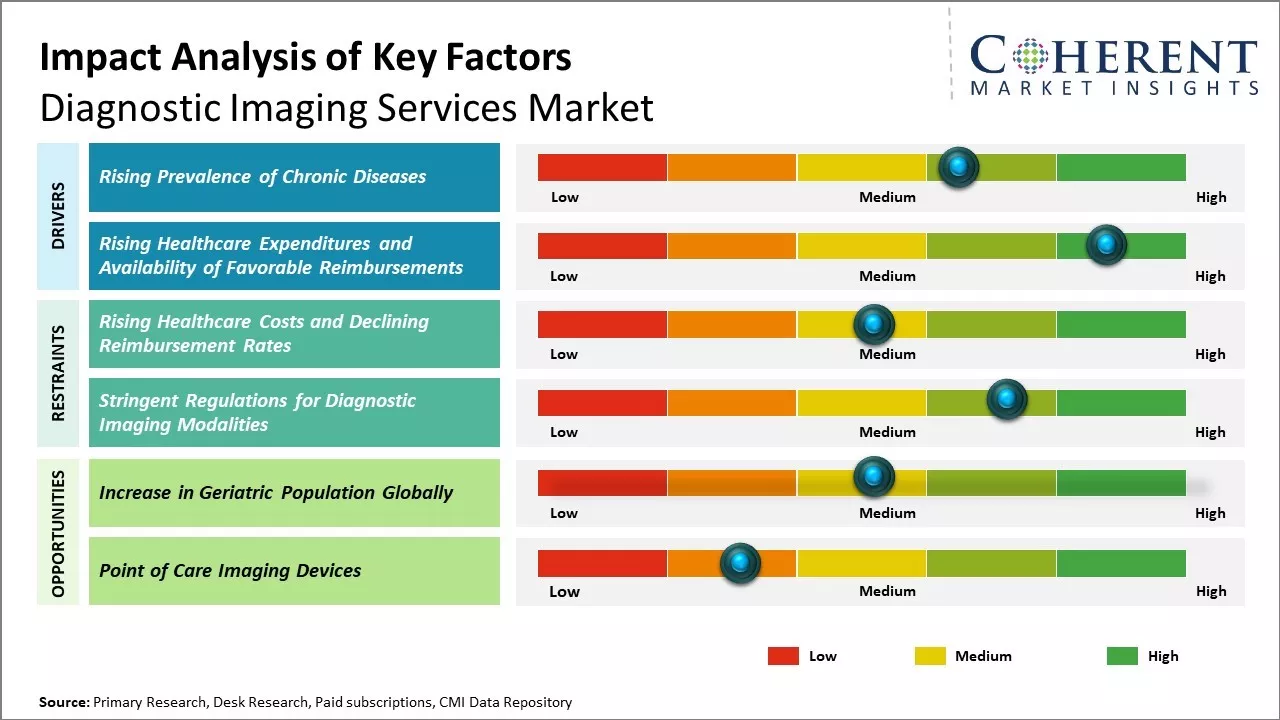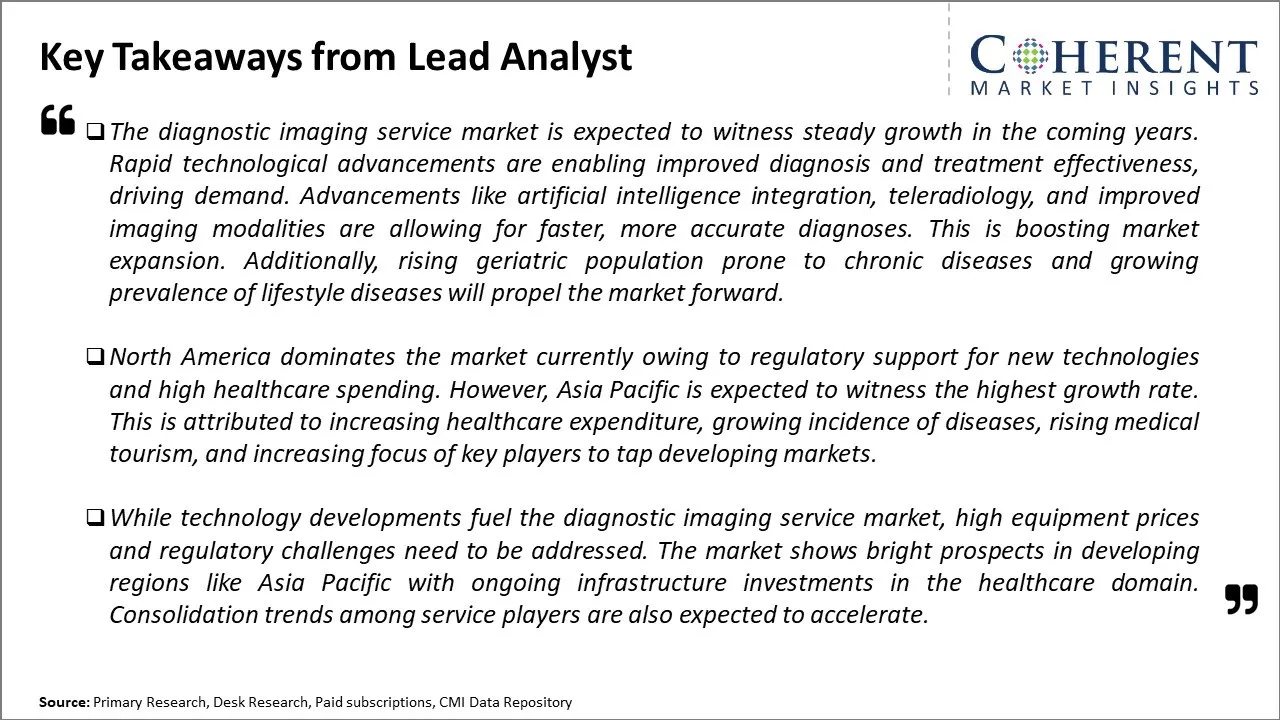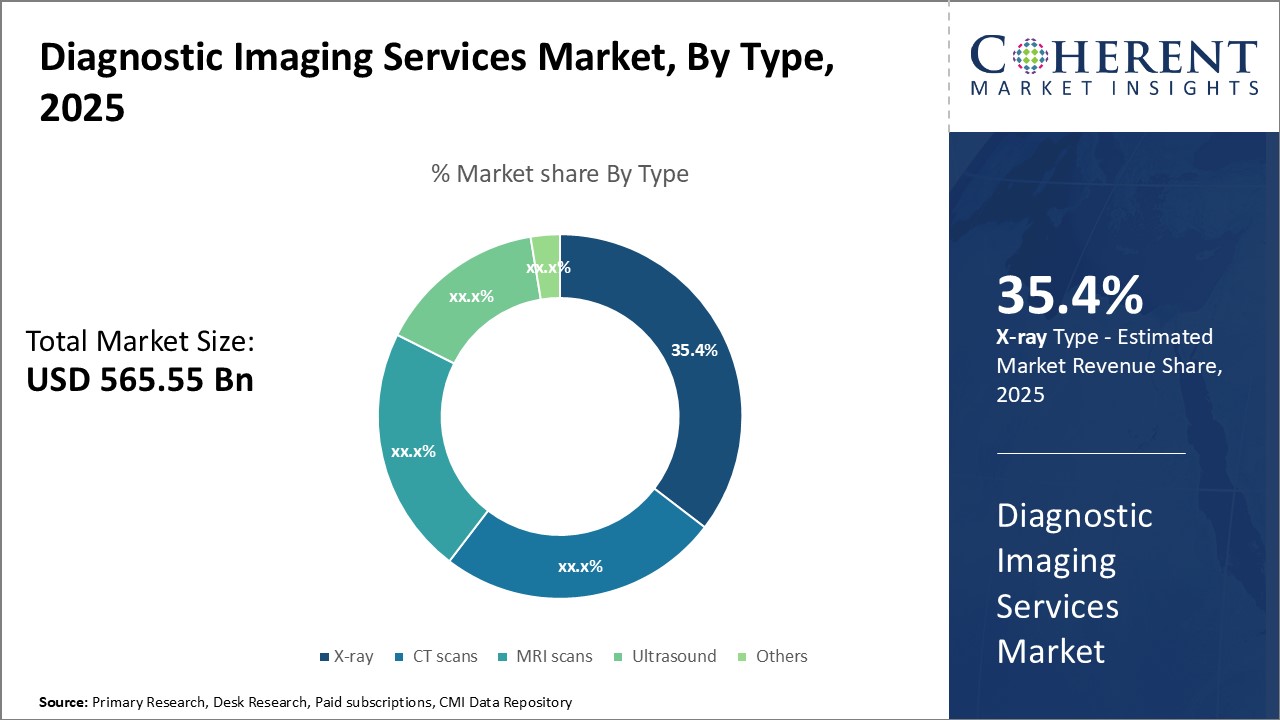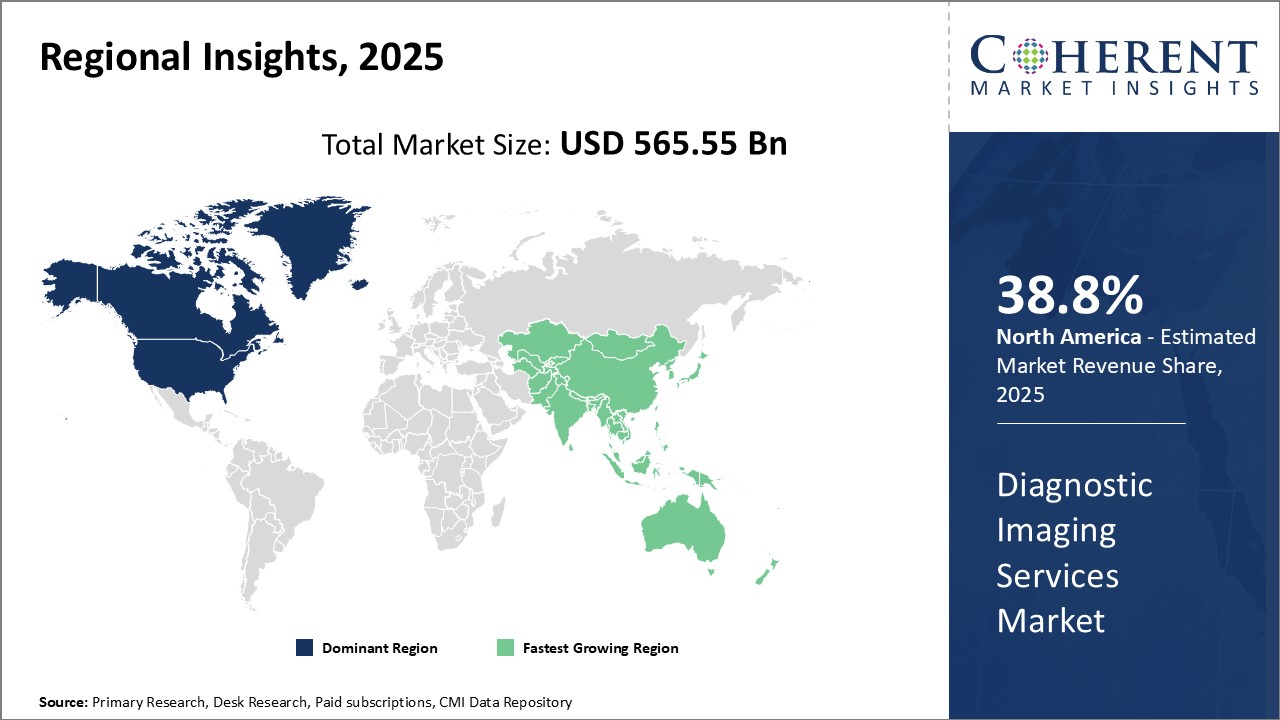Diagnostic Imaging Services Market Size and Trends
The diagnostic imaging services market is estimated to be valued at USD 565.55 Bn in 2025 and is expected to reach USD 845.34 Bn by 2032, exhibiting a compound annual growth rate (CAGR) of 5.9% from 2025 to 2032.

Discover market dynamics shaping the industry: Download Free Sample
The diagnostic imaging services market is expected to grow steadily over the forecast period. Key factors, such as rising geriatric population prone to chronic diseases, technological advancements in diagnostic imaging modalities, increasing investments and reimbursements for disease diagnosis, and surging demand for early disease diagnosis will contribute to the growth of this market between 2025 and 2032. Advanced technologies, such as 3D ultrasound, mobile MRI systems, and interventional imaging solutions, are enhancing disease detection capabilities. Greater acceptance of diagnostic imaging for clinical decisions is also augmenting the demand. Furthermore, supportive government initiatives for improving health services will provide impetus to the market. However, the dearth of skilled professionals and high costs associated with advanced systems may hinder the market growth to some extent.
Rising Prevalence of Chronic Diseases
As the global population is aging significantly, especially in developed countries, there is a rising prevalence of chronic and lifestyle diseases. Older individuals are more susceptible to conditions like cancer, cardiac ailments, orthopedic disorders, and neurological diseases. Diagnostic imaging tests play a pivotal role in the early and accurate diagnosis of such illnesses. They help in the proper staging of cancer, determining the severity of cardiac issues, assessing bone fractures or joint problems, and evaluating brain abnormalities. Advanced modalities like CT, MRI, ultrasound, and nuclear medicine scans provide detailed internal views of the human body that often traditional examination cannot match. This growing disease burden coupled with an increase in life expectancy is anticipated to drive greater demand for diagnostic services across hospitals, imaging centers, and physician offices worldwide.
Market Concentration and Competitive Landscape

Get actionable strategies to beat competition: Download Free Sample
Rising Healthcare Expenditures and Availability of Favorable ReimbursementsHigher expenditures on healthcare have made diagnostic imaging increasingly affordable and accessible to broader patient groups over time. Government bodies and private insurance companies in many developed markets are inclined to reimburse the costs of recommended medical scans. This encourages more individuals to opt for such tests without worrying too much about out-of-pocket expenses. It also provides financial incentive for physicians to prescribe appropriate imaging services for suspicions or confirmation of diseases. Advanced economies continue investing heavily in their public health infrastructure and systems. While spending on novel drug development and specialty treatments rises, investments into diagnostic technologies remain integral to facilitate timely clinical decision making. Affluent patients in developing markets can also avail costly scans due to the presence of top-quality medical tourism destinations and private insurance coverage. Such expenditure and favorable norms have played a role in pushing volumes higher for major imaging modalities in both hospital and freestanding centers globally.

To learn more about this report, Download Free Sample
Market Challenges – Rising Healthcare Costs and Declining Reimbursement RatesThe diagnostic imaging service market is facing challenges due to rising healthcare costs and declining reimbursement rates. With rising operational costs, it is becoming difficult for diagnostic imaging centers and hospitals to maintain profitability. Additionally, the market is experiencing a shortage of specialized medical professionals like radiologists and technicians. It is a huge challenge for players in this market to recruit and retain skilled labor.
Market Opportunities – Increase in Geriatric Population Globally
The increase in geriatric population globally is driving the demand for various diagnostic imaging services. The growing prevalence of chronic diseases like cancer, cardiovascular diseases, etc. presents a major opportunity for players in this market. Furthermore, technological advancements in diagnostic imaging modalities like MRI, CT, ultrasound, etc. allow for earlier disease detection. This has increased the demand for various advanced imaging procedures. There is also opportunity for market consolidation as small players are seeking mergers or partnerships with bigger brands for better access to new technologies and revenue streams.

Discover high revenue pocket segments and roadmap to it: Download Free Sample
Insights, By Type: Precise Imaging for Targeted DiagnosisThe type segment includes X-ray, CT scans, MRI scans, ultrasound, and others. The CT scans segment is estimated to hold 35.4% share of the market in 2025 owing to its ability to provide highly precise cross-sectional images of the body. CT scanning utilizes rotating X-ray beams and advanced computer technology to generate clear, detailed images of internal organs, bones, soft tissues, and blood vessels. Unlike general radiography and ultrasound, CT scanning allows clinicians to peer inside the body and obtain tomographic slices of the area being studied. This precise cross-sectional view enables physicians to identify and diagnose medical conditions with a high level of accuracy. CT scans are especially valuable for imaging the chest, abdomen, and pelvis due to their ability to differentiate between various soft tissues. The detailed images produced by CT scans make it well-suited for identifying lesions, tumors, blood clots, infections and other abnormalities that may not be visible on conventional radiography. It is commonly used to comprehensively evaluate the lungs for signs of cancer, emphysema or blood clots. CT scanning of the abdomen and pelvis helps diagnose conditions affecting the digestive tract, kidneys, liver, pancreas and other abdominal organs. Other advantages of CT scanning include short exam times and its non-invasiveness compared to procedures such as biopsy or surgery.
Insights, By Application: Cardiac Care through Imaging
The application segment includes cardiology, neurology, oncology, orthopedics, and others. The cardiology subsegment is expected to account for 30.3% of the market share in 2025 due to the increasing usage of non-invasive techniques. Coronary artery disease is a leading cause of death and disability worldwide. However, many conditions affecting the heart can now be diagnosed using imaging modalities such as echocardiography, MRI, nuclear scanning, and most commonly, coronary angiography. Cardiac ultrasound, also known as echocardiography, provides real-time images of the heart structures to assess heart function and evaluate potential problems such as enlarged chambers, decreased pumping ability, or valve abnormalities. It does not use radiation and has become a standard first-line imaging exam for many cardiac issues. MRI and CT angiography are also frequently used instead of conventional angiography to visualize coronary arteries in a non-invasive manner. MRI in particular can clearly depict heart muscle and does not require ionizing radiation. However, catheter coronary angiography remains a mainstay due to its unrivaled accuracy for detecting coronary artery narrowing. The images gained from injecting contrast dye into the arteries through tiny tubes allow interventional cardiologists to effectively treat issues found on angiography through procedures such as balloon angioplasty and stenting. Nuclear cardiac imaging using radioactive tracers is also valuable for assessing blood flow to the heart muscle and identifying areas of poor perfusion. The growth of the cardiology application segment stems from an aging global population and increasing diagnosis and treatment of life-threatening heart conditions. Continued technological developments will expand the important role of noninvasive imaging in revolutionizing cardiac care.
Insights, By End User: Centralized Healthcare Services
The end user segment includes hospitals, diagnostic centers, and others. The hospitals subsegment is expected to hold 41.8% of the market share in 2025 due to their role as centralized healthcare institutions. The high cost and expertise required to operate medical imaging equipment has traditionally made hospitals the focal point for diagnostic imaging services. As full-service providers, hospitals utilize an extensive array of imaging modalities for diagnosis, treatment planning and post-procedure follow up care. As reimbursement decreases healthcare trends push toward more affordable settings, some elective imaging services are migrating to physician offices and free-standing centers. However, hospitals will remain the cornerstone of diagnostic imaging due to demand for multi-modality services, emergency imaging access and specializations like interventional radiology that require full hospital facilities. While other sectors have a growing role, hospitals are positioned to continue dominating the end user segment through centralized, comprehensive imaging care.
Regional Insights

Need a Different Region or Segment? Download Free Sample
North America remains the dominant region in the global diagnostic imaging services market and is anticipated to hold 38.8% of the market share in 2025. North America has established itself as the dominant region in the global diagnostic imaging services market. With highly developed healthcare infrastructure and strong presence of leading industry players, the U.S. market alone accounts for over 40.5% share. Countries in the region have witnessed a widespread adoption of advanced diagnostic technologies at both hospitals and diagnostic centers. Moreover, favorable reimbursement policies have ensured the high affordability of diagnostic scans.
The Asia Pacific region has emerged as the fastest growing diagnostic imaging services market worldwide. Rapid economic development and growing medical tourism in countries such as India, China, and South Korea are driving significant growth. Governments in the region have undertaken various initiatives to modernize and expand the domestic healthcare infrastructure. This has increased accessibility to diagnostic centers, especially in tier 2/3 cities. Rising medical awareness, growing burden of lifestyle diseases, and increasing private healthcare expenditures are expected to sustain the momentum. A young population combined with rising incomes points towards a long growth runway for the industry. Policy support through public-private partnerships can help the region to emerge as a global manufacturing and innovation hub in the coming years.
Market Report Scope
Diagnostic Imaging Services Market Report Coverage
| Report Coverage | Details | ||
|---|---|---|---|
| Base Year: | 2024 | Market Size in 2025: | USD 565.55 Bn |
| Historical Data for: | 2020 To 2024 | Forecast Period: | 2025 To 2032 |
| Forecast Period 2025 to 2032 CAGR: | 5.9% | 2032 Value Projection: | USD 845.34 Bn |
| Geographies covered: |
|
||
| Segments covered: |
|
||
| Companies covered: |
RadNet, Inc., Akumin Inc., Novant Health, RAYUS Radiology, MedQuest Associates, Concordmedical, Lucid Medical Diagnostics, Radiology Partners, Envision Radiology, Capitol Imaging Services, Statim Healthcare, InHealth Group, Global Diagnostic Imaging, an dADM Diagnostics, Inc. |
||
| Growth Drivers: |
|
||
| Restraints & Challenges: |
|
||
Uncover macros and micros vetted on 75+ parameters: Get instant access to report
Market Segmentation
- Type Insights (Revenue, USD Bn, 2020 - 2032)
- X-ray
- CT scans
- MRI scans
- Ultrasound
- Others
- Application Insights (Revenue, USD Bn, 2020 - 2032)
- Ancestry Testing
- Diet & Nutrition
- Disease Risk Assessment
- Others
- End User Insights (Revenue, USD Bn, 2020 - 2032)
- Hospitals
- Diagnostics & Forensics Laboratories
- Academic & Research Institutes
- Others
- Regional Insights (Revenue, USD Bn, 2020 - 2032)
- North America
- U.S.
- Canada
- Latin America
- Brazil
- Argentina
- Mexico
- Rest of Latin America
- Europe
- Germany
- U.K.
- Spain
- France
- Italy
- Russia
- Rest of Europe
- Asia Pacific
- China
- India
- Japan
- Australia
- South Korea
- ASEAN
- Rest of Asia Pacific
- Middle East
- GCC Countries
- Israel
- Rest of Middle East
- Africa
- South Africa
- North Africa
- Central Africa
- North America
- Key Players Insights
- RadNet, Inc.
- Akumin Inc.
- Novant Health
- RAYUS Radiology
- MedQuest Associates
- Concordmedical
- Lucid Medical Diagnostics
- Radiology Partners
- Envision Radiology
- Capitol Imaging Services
- Statim Healthcare
- InHealth Group
- Global Diagnostic Imaging
- ADM Diagnostics, Inc.
Share
Share
About Author
Komal Dighe is a Management Consultant with over 8 years of experience in market research and consulting. She excels in managing and delivering high-quality insights and solutions in Health-tech Consulting reports. Her expertise encompasses conducting both primary and secondary research, effectively addressing client requirements, and excelling in market estimation and forecast. Her comprehensive approach ensures that clients receive thorough and accurate analyses, enabling them to make informed decisions and capitalize on market opportunities.
Missing comfort of reading report in your local language? Find your preferred language :
Transform your Strategy with Exclusive Trending Reports :
Frequently Asked Questions
EXISTING CLIENTELE
Joining thousands of companies around the world committed to making the Excellent Business Solutions.
View All Our Clients
